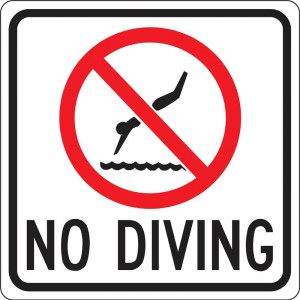Safer Swimming

No Diving Sign
Your swimming pool is beautiful, fun, and relaxing, but it also presents a risk in your backyard that has to be properly managed. From mechanical safeguards, to proper enclosures, to owner awareness and preparedness, there are multiple layers of protection necessary to prevent accidents, reduce liability and ensure the safety or your family and friends.
Mechanical Safeguards
- Install the newest code-compliant drain covers. The newest approved designs reduce the possibility of hair entrapment as well as mechanical entrapment. These new grates also offer increased flow rates that reduce entrapment potential.
- Upgrade your pool pump. Significant advancements in technology have been made recently. The newest versions combine vacuum release (SVRS) features as well as energy saving variable speed features (VS) that make your pool safer and more economical to operate.
- Split single-suction main drains in your pool and/or spa. SVRS protection and code-compliant grates should also be installed.
- Install a hard foam spa cover. They are energy efficient and ASTM safety approved.
Enclosures
- Install self-closing & self-Latching systems. Code now requires that all doors and gates leading to the pool are self-closing and self-latching.
- Secure and alarm all doors leading to the pool. Approved door alarms have the proper decibel requirements and pass through features to avoid false alarms.
- Check pool perimeter fencing and repair any damage. Be sure that neighbors do not install structures too close to the fence that can provide climbing access to your pool. Current code requires that no openings be greater than 4”and that the bottom of fence can be no more than 2” from the ground.
Owner Awareness and Preparedness
- Never leave a child alone in the pool or pool area for any reason. Always provide adult supervision and make sure that the adult watching is a capable swimmer.
- Educate your children as to where potential problems exist in your pool. Identify suction outlets and encourage them to avoid these areas. Also show them how to shut the pool off if necessary.
- Keep rescue devices visible and accessible in the pool area. Make sure all swimmers and those watching know how to use them if needed.
- Remove all toys from the pool and pool area. When not swimming, remove toys or other objects from the pool and pool area that might attract a child’s attention or curiosity.
- Never swim in the pool if the cover is partially opened or closed. If the cover is stuck, contact your pool service company immediately to schedule a repair.
- Prohibit diving by all swimmers.
- Prohibit horseplay and aggressive behavior.
- Post pool rules. Make a list of safety rules and post them visibly in the pool area.
- Learn CPR. At Shoreline, we recommend that all pool owners become CPR and First Aid certified. Enroll children in swimming classes to learn to swim and be educated about pool safety. Local YMCA’s generally offer classes. Be sure to keep these certifications current.
Please keep in mind that safety technology advancements and building code changes are made frequently. If you pool is more than 2 years old, we recommend scheduling a safety inspection with your pool service professional to evaluate the current condition of your pool, make recommendations, and alert you of new technology available. Keep in mind that older pools, although built to proper code at the time of construction, may no longer be code-compliant and a pool professional can help identify non-compliant features.





